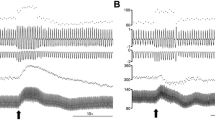Summary
1. The effects of microinjection of 5-hydroxytryptamine (5-HT) or its antagonists methysergide (a 5-HT1 receptor antagonist), cyproheptadine (a mixed 5-HT1/5-HT2 receptor antagonist), or ketanserin (a 5-HT2 receptor antagonist) into the preoptic anterior hypothalamus on thermoregulatory responses were assessed in conscious rabbits at different ambient temperatures (T a). 2. Intrahypothalamic injection of 5-HT caused dose-dependent hypothermia in rabbits when the T a was 2°C and 22°C. At 2°C the hypothermia was due to decreased metabolism, whereas at 22°C the hypothermia was due to increased peripheral blood flow and increased respiratory evaporative heat loss. 3. In contrast, administration of either cyproheptadine, methysergide or ketanserin into the 5-HT-sensitive sites in the preoptic anterior hypothalamus caused dose-dependent hyperthermia in rabbits when the T a was 2°C, 22°C and 32°C. At 2°C the hyperthermia was due to increased metabolism, whereas at 32°C the hyperthermia was due to decreased peripheral blood flow and decreased respiratory evaporative heat loss. At 22°C, the hyperthermia was due to increased metabolism and decreased peripheral blood flow. 4. For a given intrahypothalamic dose (e.g.15–20 μg), either methysergide, cyproheptadine or ketanserin produced the same degree of rectal temperature elevation (e.g. about 1.4°C) in rabbits. Thus, there did not appear to be any association between hypothalamic 5-HT receptor types and thermoregulation. 5. However, the present results suggest that hypothalamic 5-HT receptors mediate thermoregulatory responses in the rabbit. Activation of hypothalamic 5-HT receptors decreases heat production and increases heat loss, whereas inhibition of hypothalamic 5-HT receptors increases heat production and decreases heat loss in the rabbit.
Similar content being viewed by others
References
Bligh JL, Cottle WH, Maskrey M (1971) Influence of ambient temperature on the thermoregulatory responses to 5-hydroxytryptamine, noradrenaline and acetylcholine injected into the lateral cerebral ventricles of sheep, goats and rabbits. J Physiol 212:377–392
Clark WG, Lipton JM (1986) Changes in body temperature after administration of adrenergic and serotonergic agents and related drugs including antidepressants. II. Neurosci Biobehav Rev 10:153–220
Cooper JR, Bloom FE, Roth RH (1986) The biochemical basis of neuropharmacology. Oxford University, New York
Cooper KE, Cranston WI, Honour AJ (1965) Effects of intraventricular and intrahypothalamic injection of norepinephrine and 5-HT on body temperature in conscious rabbits. J Physiol 181:852–864
Cranston WI, Rosendorff C (1967) Central temperature regulation in the conscious rabbits after monoamine oxidase inhibition. J Physiol 193:359–373
Dahlström A, Fuxe K (1965) Evidence for the existence of monoamine neurons in the cell bodies of brain stem neurons. Acta Physiol Scand Suppl 232:1–55
Girault JMT, Jacob JJ (1979) Serotonin antagonists and central hyperthermia produced by biogenic amines in conscious rabbits. Eur J Pharmacol 53:191–200
Gordon CJ, Heath JE (1981) Effect of monoamines on firing rate and thermal sensitivity of neurons in the preoptic area of awake rabbit. Exp Neurol 72:352–365
Green AR, Heal DJ (1985) The effects of drugs on serotonin-mediated behavioural models. In: Green AR (ed) Neuropharmacology of serotonin. Oxford University, Oxford, pp 326–365
Hellon RF (1975) Monoamines, pyrogens and cations: Their action on central control of body temperature. Pharmacol Rev 26:289–321
Hellstrand K, Hermodsson S (1987) Role of serotonin in the regulation of human natural killer cell cytotoxicity. J Immunol 139:869–875
Horita A, Gogerty JH (1958) The pyretogenic effect of 5-hydroxytryptophan and its comparison with that of LSD. J Pharmacol Exptl Therap 122:195–200
Lin MT (1980a) Effects of brain monoamine depletion on thermoregulation in rabbits. Am J Physiol 238:R364-R371
Lin MT (1980b) An antagonism between 5-hydroxytryptamine and norepinephrine in thermally responsive units in the rabbit hypothalamus. Exptl Neurol 67:611–620
Lin MT, Pang IH, Chern ST, Chia WY (1978) Changes in serotonin contents in brain affect metabolic heat production of rabbits in cold. Am J Physiol 235:R41-R47
Lin MT, Jou JJ, Ko WC (1981) Effects of intracerebroventricular injection of clonidine on metabolic, respiratory, vascular and temperature responses in the rabbit. Naunyn-Schmiedeberg's Arch Pharmacol 315:195–201
Lin MT, Wu JJ, Tsay BH (1983) Serotonic mechanisms in the hypothalamus mediate thermoregulatory responses in rats. Naunyn-Schmiedeberg's Arch Pharmacol 322:271–278
Sawyer CH, Everette JW, Green JD (1954) The rabbit diencephalon in stereotaxic coordinates. J Comp Neurol 101:801–824
Sgaragli G, Carla V, Magnani M, Galli A (1981) Hypothermia induced in rabbits by intracerebroventricular taurine: specificity and relationships with central serotonin (5-HT) systems. J Pharmacol Exp Ther 219:778–785
Tangri KK, Misra N, Bhargava KP (1976) Central cholinergic mechanism of pyrexia. In: Brazier MAB, Coceani F (eds) Brain dysfunction in infantile febrile convulsions. Raven Press, New York, pp 89–106
Turlejska, E, Lyszczarz J (1982) Dehydration attenuates panting response to intraventricular 5-hydroxytryptamine in the rabbit. Brain Res 242:383–386
Van de Kar LD, Lorens SA, Vodraska A, Allers G, Green MN, Van Orden DE, Van Orden LS (1980) III. Effect of selective midbrain and diencephalic 5,7-dihydroxytryptamine lesions on serotonin content in individual preoptic hypothalamic nuclei and on serum luteining hormone level. Neuroendocrinology 31:309–315
Van Nueten JM, Janssen PAJ, Van Beek J, Xhonneux R, Verbeuren TJ, Vanhoutte PM (1981) Vascular effects of ketanserin (R41468), a novel antagonist of 5-HT2 serotonergic receptors. J Pharmacol Exp Ther 218:217–230
Weber LJ, Angell LA (1967) Hyperthermia and elevated brain 5-hydroxytryptamine of rabbits in response to tryptophan and 5-hydroxytryptophan infusion. Biochem Pharmacol 16:2451–2454
Wenting GJ, Man in't Veld AJ, Woittiez AJ, Boomsma F, Schalekamp MADM (1982) Treatment of hypertension with ketanserin a new selective 5-HT2 receptor antagonist. Clin Res 284:537–539
Author information
Authors and Affiliations
Additional information
This study was supported by grants from the National Science Council of the Republic of China.
Send offprint requests to S. J. Won at the above address
Rights and permissions
About this article
Cite this article
Won, S.J., Lin, M.T. 5-hydroxytryptamine receptors in the hypothalamus mediate thermoregulatory responses in rabbits. Naunyn-Schmiedeberg's Arch Pharmacol 338, 256–261 (1988). https://doi.org/10.1007/BF00173397
Received:
Accepted:
Issue Date:
DOI: https://doi.org/10.1007/BF00173397




